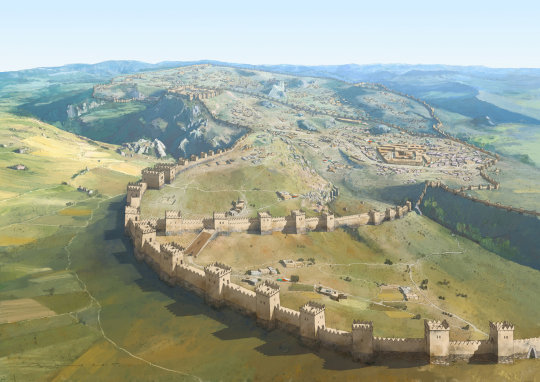#hattusa
Text

Capital of the Hittite Empire between 1420 and 1200 BC. Hattusa now lies in ruins beside Boğazkale, Turkey.
Learn more / Daha fazlası
https://www.archaeologs.com/w/hattusas/
#archaeologs#archaeology#archaeological#history#dictionary#art#hittite#hittite empire#hattusa#hattusas#illustration#hattuşa#arkeoloji#tarih#sanat#hitit#hitit imparatorluğu
68 notes
·
View notes
Text
During excavations at the ancient Hittite capital, Hattusa, archaeologists have found a clay tablet that contains a previously unknown language!
107 notes
·
View notes
Text
Spectacular find.
18 notes
·
View notes
Text

Cultic statue of a male figure
Tell Halaf, Syria
Late Hittite Period
Statue of a male from the cult room at Tell Halaf,
Late Hittite period (c. 800 BCE?)
Housed at the Adana Museum, Turkey
4 notes
·
View notes
Text
I can’t describe the feeling whenever I see a piece of writing from the Bronze Age mention the Minoans or the Harrapan civilization. They’re a total mystery to us now, but to the Hittites they were just other foreign peoples. No more mysterious than the Greeks or the Egyptians.
#Bronze#Bronze Age#ancient history#ancient crete#minoans#minotaur#indus valley#mesopotamia#Anatolia#city state#mycenaean greece#Hattusa
20 notes
·
View notes
Link
14 notes
·
View notes
Text
Babe, stop collapsing the Bronze Age.
You’re scaring the Hittites!
#personal stuff#dougie rambles#what#no context#shitpost#my poor attempt at a joke#Bronze Age shitposting#hittites#anatolia#hattusa#bronze age#bronze age memes#bronze age collapse#sea people#highbrow shitposting
5 notes
·
View notes
Quote
"If a man has sexual relations with a cow, it is an unpermitted sexual pairing: he will be put to death."
Similar relations with horses and mules were not subject to capital punishment, but the offender could not become a priest afterwards.
Ancient Hittites’ Laws
(aka the Khatti they coopted -> Khatri/Kshatriya of India)
#hittite#hittites#indo european#anatolia#indoeuropean#vedic#abrahamic#christianity#priest#turkey#syria#hattusa#levant#mitanni#hattic#sanskrit#khatti#khatri#kshatriya#caste#india
2 notes
·
View notes
Text
El colapso de la Edad del Bronce fue la caída repentina de casi todas las civilizaciones del Mediterráneo oriental en solo 50 años. Aquí hay siete de esas civilizaciones perdidas de la edad de oro de Grecia y el Medio Oriente.
3 notes
·
View notes
Text

Sanktuarium Hattusa Yazilikaya stolicy imperium Hetytów (Arkadiusz Miodek)
#płaskorzeźba#ryty#rytynaskalne#sztuka#sanktuarium#hattusayazilikaya#sanktuariumhattusayazilikaya#hetyci#imperiumhetytów#hattusa#turcja#arek#arkadiusz#arkadiuszmiodek#arekmiodek#aremioart#aremio#amiod
1 note
·
View note
Text
The intriguing world of Hittite symbolic artistry has been exhibited with the discovery of a Hattusa ivory masterpiece! Freshly unearthed after 117 years of excavation at the site, this 2,800-year-old artifact, adorned with sphinxes, lions, and trees of life, is a true testament to the rich history of the late Bronze Age of Anatolia.
32 notes
·
View notes
Text
Great find!
9 notes
·
View notes
Text
Jetez un œil à cette histoire que j'ai sauvegardée sur Pocket
https://www.geo.fr/histoire/pourquoi-la-puissante-civilisation-hittite-sest-elle-effondree-il-y-a-plus-de-3000-ans-213481?utm_source=pocket_mylist
Effondrement de la civilisation ?
Droughts at home.
Outside home, son, outside home...
#nature#news#history#economy#humankind#hittites#anatolia#hattusa#end of empire#droughts#climatic changes
1 note
·
View note
Text

A 2,800-Year-Old Ivory-Decorated Piece Discovered in Turkey
An ivory-decorated piece, estimated to be approximately 2,800 years old, was found during the archaeological excavation in the Hattusa Ancient City in Çorum, the heart of Turkey.
The Hittite capital’s ruins date back to the Bronze Age, around 2000 BC. In 1986, the site was inscribed on the UNESCO World Heritage list.
Hattusha, which was also included in UNESCO’s “Memory of the World List” in 2001, as it contains cuneiform tablet archives representing the oldest known Indo-European language, has the title of the only ancient city in both lists of UNESCO.
Excavations that started 116 years ago in the ancient city of Hattusa are still ongoing. Excavations have been carried out on behalf of the German Archaeological Institute since 2006, under the direction of Professor Andreas Schachner.
In the 117th year of the excavations, a work revealing information about the artistic structure of the Iron Age was unearthed on the northwest slope of the Great Fortress area of the ancient city.
The ivory piece, which is approximately 30 centimeters long and 10 centimeters wide, features a sphinx (a statue with a human head and an animal body), a lion, and two Tree of Life figures drawn on a shiny background.
Scientific studies are ongoing regarding the piece on which the figures can be seen under suitable light conditions due to the layer on it.

Excavation Director Prof. Dr. Andreas Schachner told AA correspondent that the artifact was found in the Iron Age layer at the Hattusa Archaeological Site, which bears traces of many civilizations.
Schachner, stating that the well-preserved piece is approximately 2,800 years old, said, ‘In its period, it was most likely added as a decoration to a wooden box or furniture made of wood. The artifact is broken on the right and left sides, and the upper and lower sides are in their original state. Therefore, we guess that the piece is longer.”
Schachner, the significance of the piece, explained:
“This artifact is a unique work for Boğazköy. For the first time, we are confronted with a piece adorned with a scene so intricately and beautifully crafted. Extensive excavations have been conducted in Boğazköy for the Iron Age, but we have not come across such a detailed work.
In terms of both the stage and the iconography and style used, we can better reveal the relations of Boğazköy towards Southeastern Anatolia and its artistic relations towards the Southwest and Greece in its period, that is, in the first millennium BC. “
Schachner added that the work will be exhibited at Boğazköy Museum after completing the scientific studies.
By Leman Altuntaş.

#A 2800-Year-Old Ivory-Decorated Piece Discovered in Turkey#Ancient City of Hattusa#ancient artifacts#archeology#archeolgst#history#history news#ancient history#ancient culture#ancient civilizations#Iron Age#Iron Age art
82 notes
·
View notes


